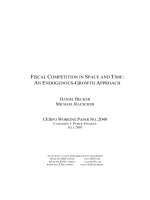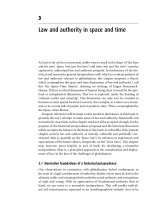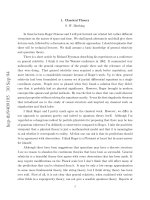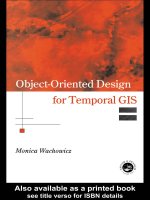FISCAL COMPETITION IN SPACE AND TIME: AN ENDOGENOUS-GROWTH APPROACH
Bạn đang xem bản rút gọn của tài liệu. Xem và tải ngay bản đầy đủ của tài liệu tại đây (333.03 KB, 29 trang )
F
ISCAL
C
OMPETITION IN
S
PACE AND
T
IME
:
A
N
E
NDOGENOUS
-G
ROWTH
A
PPROACH
D
ANIEL
B
ECKER
M
ICHAEL
R
AUSCHER
CES
IFO
W
ORKING
P
APER
N
O
.
2048
C
ATEGORY
1:
P
UBLIC
F
INANCE
J
ULY
2007
An electronic version of the paper may be downloaded
•
from the SSRN website: www.SSRN.com
•
from the RePEc website: www.RePEc.org
•
from the CESifo website:
T
www.CESifo-group.de
T
CESifo Working Paper No. 2048
F
ISCAL
C
OMPETITION IN
S
PACE AND
T
IME
:
A
N
E
NDOGENOUS
-G
ROWTH
A
PPROACH
Abstract
Is tax competition good for economic growth? The paper addresses this question by means of
a simple model of endogenous growth. There are many small jurisdictions in a large
federation and individual governments benevolently maximise the welfare of immobile
residents. Investment is costly: Quadratic installation and de-installation costs limit the
mobility of capital. The paper looks at optimal taxation and long-run growth. In particular, the
effects of variations in the cost parameter on economic growth and taxation are considered. It
is shown that balanced endogenous growth paths do not always exist and effects of changes in
installation costs are ambiguous.
JEL Code: H21, H72, O41.
Daniel Becker
University of Rostock
Department of Economics
18051 Rostock
Germany
Michael Rauscher
University of Rostock
Department of Economics
18051 Rostock
Germany
Financial support by the Deutsche Forschungsgemeinschaft through their SPP 1422
programme on Institutional Design of Federal Systems is gratefully acknowledged.
Fiscal Competition in Space and Time:
An Endogenous-Growth Approach
Daniel Becker and Michael Rauscher*
*
1 The Issue
Tax competition has been an important issue in public economics in the past two
decades. Static models have shown that there is a tendency for underprovision of
services provided by the public sector emerging from fiscal externalities when the
tax base is mobile and the use of non-distorting taxes is restricted. See Wilson
(1999) for an overview. This paper attempts to extend this literature to an economic-
growth context and poses the question whether an increase in the intensity of
competition for a mobile tax base enhances economic growth.
When there is competition for a mobile tax base like capital, the taxing power of
governments is limited by the threat of capital owners to withdraw their capital if
they consider the tax rates to be too high. Most models of tax competition assume
that capital flight is cost-free and capital mobility therefore is perfect. Wildasin
(2003) has shown how a dynamic formulation of an otherwise standard model of tax
competition can be used to incorporate the more realistic case of imperfect capital
mobility. In his model, firms face adjustment costs of the type suggested by Hayashi
(1982) and Blanchard/ Fischer (1989, ch. 2.4) in their macroeconomic growth
models. An instantaneous relocation of the capital stock as a response to a tax
increase does then not occur as long as the adjustment cost function is convex.
Instead, capital flight is a time consuming process where the speed of adjustment to
a new steady state can be taken as a measure for capital mobility. Wildasin's article
is concerned with an economy that approaches a static long-run equilibrium and it
shows that the capital tax rate is positive and that it increases with increasing
adjustment cost. The present paper, in contrast, looks at a model of endogenous
growth where the steady state is a balanced growth path. It will be seen that not all
results carry over from exogenous-growth to endogenous-growth models.
Endogenous growth in this paper is sustained by the provision of public services
to firms. We follow the approach taken by Barro (1990) and model a public sector
that uses tax revenue to provide a flow of services to firms. Hence, we analyse an
AK-type growth model. Mainly because public inputs are not modelled as a stock
*
Becker: Department of Economics, Rostock University, Rauscher: Department of Econ-
omics, Rostock University, and ifo Institute Munich. Financial support by the Deutsche
Forschungsgemeinschaft through their SPP 1422 programme on Institutional Design of
Federal Systems is gratefully acknowledged
2
variable, there are no transitional dynamics for the evolution of output and physical
capital.
1
The set of instruments at hand of the policymaker is restricted and
distorting taxes become desirable. In particular, capital owners cannot be taxed
lump-sum. Thus redistribution has to be financed by distorting taxes. The central
question will then be how the choice of tax rates is influenced by the degree of tax
competition and how this affects growth.
The analysis of endogenous growth in open economies has been mainly
concerned with the issue of convergence, i.e. the question if countries tend to
converge to a common growth rate and how this uniform growth rate is reached by
an individual country, see for example Rebelo (1992). Another central question is
the relationship between savings and investment. As has been shown by Turnovsky
(1996) for a small open economy with endogenous growth, the presence of
adjustment-costs allows for different growth rates of physical capital and financial
assets. This is not only interesting by itself but has also consequences for taxation. In
equilibrium, the after-tax returns of physical capital and financial assets must be
equalized. When the interest rate earned by financial assets is exogenous to decision-
makers, this also determines the after-tax return of physical capital and the set of
available tax policies in equilibrium is heavily constrained by the model-setup.
Adjustment costs however drive a wedge between the rates of return of financial
assets and physical capital such that the choice of arbitrary tax policy is possible and
an interesting problem even in a small open economy. While our modelling of
endogenous growth is close to Turnovsky (1996), we extend his model by
considering the implications of tax competition for the choice of public policy as in
Wildasin (2003).
The literature on tax competition and growth is still rather small. A major
complication is the fact that optimising governments use private-sector first-order
conditions as constraints. This implies there are second derivatives in the optimality
conditions. This problem can be solved in static models of tax competition. In
dynamic growth models matters are often less simple. However, in some models,
particularly those with benevolent governments and purely redistributive taxation,
second derivatives cancel out if it is assumed that workers do not save. This is the
modelling strategy followed in this paper. Other papers on growth and tax
competition include Lejour/Verbon (1997), Razin/Yuen (1999) and Rauscher
(2005). Lejour/Verbon (2005) look at a two-country model of economic growth.
Besides the conventional fiscal externality leading to too-low taxes they identify a
growth externality. Low taxes in one country increase the growth rate in the rest of
the world. If this effect dominates the standard fiscal externality due to competition
for a mobile tax base, uncoordinated taxes will be too high. This contrasts the
1
Models of public policy and growth that address the importance of modelling public
capital as a stock variable include Futagami et al. (1993) and Turnovsky (1997).
3
finding of the standard static tax-competition models that taxes tend to be too low.
Razin/Yuen (1999) look at a more general model that also includes human-capital
accumulation and endogenous population growth. They come to the conclusion that
optimum taxes should be residence-based, capital taxes should be abolished along a
balanced growth path, and taxes will be shifted from the mobile to the immobile
factor of production if the source principle is applied in a world of tax-competing
jurisdictions. Their results extend those derived by Judd (1985) and are in
accordance with the standard economic intuition. The underlying assumption is that
the government's set of tax instruments is large enough such that distortion-free
taxation becomes feasible. Rauscher (2005) uses an ad-hoc model of limited inter-
jurisdictional capital mobility and comes to the conclusion that the effects of
increased mobility are ambiguous. A central parameter in this context is the
elasticity of intertemporal substitution, which does not only affect the magnitude of
the economic growth rate, but also the signs of the comparative static effects.
In the centre of our approach to model tax competition and growth are public
inputs as the source for sustainable growth and adjustment costs causing imperfect
mobility of capital. We consider a continuous-time infinite-horizon framework. As
in most other models of tax competition, we look at a federation consisting of a large
number of very small jurisdictions that have no power to affect economic variables
determined on the federal level. In the present analysis, the only variable determined
on the federal level will be the interest rate. Given the interest rate, governments
choose their policies, which are then announced to the private sector. The private
sector consists of a continuum of identical agents acting under conditions of perfect
competition. In the first step of the analysis, individual economic agents will
maximise utility given the interest rate and the economic policies announced by the
government. In the next step, governments will decide about policies taking as given
the interest rate and the first-order conditions of the private sector. Finally, the
interest rate itself will be determined.
The next section of this paper will present the assumptions of the model
regarding production technology and the frictions that limit the mobility of capital.
Sections 3 and 4 will look at the behaviour of the private sector and of the
government, respectively. Section 5 closes the model by determining the interest
rate and derives the central result by investigating the impact of capital mobility on
the long-run economic-growth path. Section 6 summarises.
4
2 Definition of Variables and Characterisation of Technology
Let us consider a federation consisting of a continuum of infinitely small identical
jurisdictions, also labelled 'regions', on the unit interval. There is perfect competition
in all markets and single jurisdictions do not have any market power vis-à-vis the
rest of the federation. The private sector takes prices and policies announced by
regional governments as given. Regional governments take variables determined on
the federal level as given. As is always the case in models of tax competition, there
is a distinction between ex ante objectives and ex post outcomes of actions taken to
achieve the objectives. Ex ante, jurisdictions may be willing to use policy
instruments to affect the allocation of mobile tax bases. Ex post, however, it turns
out that all jurisdictions have acted in the same way and that the interjurisdictional
allocation of the tax base is unaffected despite the efforts taken in the first place.
There are three types of agents in this model: workers, entrepreneurs, who own
physical capital and other assets, and governments.
• Workers are immobile across jurisdictions and inelastically supply one unit of
labour per person in the perfectly competitive labour market of their home
region at the current wage rate, which they take as exogenously given.
Workers do not save and, thus, do not own physical capital or other assets.
• Capitalist producers own capital, hire labour, produce, save, and consume the
unsaved share of their incomes. Saving yields an interest rate, which is
determined on the federal capital market and which they take as exogenously
given. If they want to transform their financial assets and invest in a particular
jurisdiction, they face installation costs. If they want do withdraw physical
capital, they have to bear de-installation costs. With these costs, federal
financial assets and local physical capital are imperfectly malleable and, thus,
capital is imperfectly mobile.
• Governments
charge taxes and provide a productive input. They are
benevolent and maximise the utility of immobile residents. This includes the
possibility of income redistribution.
As all jurisdictions are identical, let us consider a representative jurisdiction.
There are three factors of production: capital, labour, and a publicly provided input,
denoted K(t), L(t), and G(t), respectively, where t denotes time. For the sake of a
simpler notation, the time argument will be omitted when this does not generate
ambiguities. Output, Q(t), is produced by means of the three factors where marginal
productivities are positive and declining. Moreover, we assume that the production
function,
Φ
(.,.,.), is linearly homogenous in (K,G) and in (K,L). An example is the
Cobb-Douglas function
( )
ααα
Φ
LGKLGKQ
−
==
1
,,
(1)
5
with 0 <
α
< 1. The size of the labour force is normalised to one. Each worker
inelastically supplies one unit of labour, i.e. L=1. Thus, (1) can be rewritten
( )(
1,,, GKGKFQ
)
Φ
≡=
(1a)
where F(.,.) is a neoclassical constant-returns-to-scale production function
measuring output per employee. A worker's income is the wage rate, w(t), which is
determined on the regional labour market. Moreover, let us introduce a production
function in intensity terms,
() ( )
KGggFgf / where,1 ≡≡
(1b)
with f'(g)>0 and f"(g)>0, primes denoting derivatives of univariate functions.
Regarding the marginal productivities we have
'gffF
KK
−==
Φ
, (2a)
'fF
GG
==
Φ
, (2b)
'KgfKFF
KL
=−=
Φ
, (2c)
where subscripts denote partial derivatives and arguments of functions have been
omitted for convenience.
Regarding the other two factors of production, we assume:
• Capital. K(t) is the quantity of a composite capital good consisting of physical
capital, human capital, and knowledge capital. Initially, each jurisdiction is
endowed with K(0)=K
0
. Capital depreciates at a constant exogenous rate m.
Let I(t) be the rate of gross investment as a share of the capital stock. Then
capital accumulation evolves according to
, (3)
()
KmIK −=
&
dots above a variable denoting its derivative with respect to time. Capital is
mobile, albeit at a finite speed. As mentioned, there is a capital market on the
federal level, yielding an interest rate r(t), which is exogenous to individual
capital owners and to governments of individual jurisdictions, but
endogenously determined by demand and supply on the federal level. Assets
and physical capital are imperfectly malleable. Transforming financial capital
into physical capital and vice versa is costly. We follow Wildasin (2003) in the
specification of the installation cost function. Installation costs are defined as
c(
Ι
) K with c(0) = 0 and c"(.) > 0.
The installation cost per unit depends on the rate of investment as a share of
capital, i.e. on the speed of gross accumulation. As c' is positive for negative
values of I, this function also covers the possibility of de-installation costs. For
the derivation of explicit results in the forthcoming sections of the paper we
assume a quadratic shape of c such that
6
()
KI
b
KIc
2
2
= , (4)
i.e. c'(I)=bI and c"(I)=b, where the constant positive parameter b measures the
barriers to mobility. b=0 represents perfect mobility and malleability. If b goes
to infinity, capital becomes absolutely immobile. For the interpretation of
some of the results to be derived in the following sections, it is useful to
introduce the absolute rate of investment, J. Using I=J/K in equation (4) yields
()
K
Jb
K
K
J
cKIc
2
2
=
⎟
⎠
⎞
⎜
⎝
⎛
=
. (4')
•
The public-sector input. The government provides a productive input at a rate
G(t). This may be interpreted as physical infrastructure such as roads and
ports, but also institutional infrastructure including the legal framework in
which economic transactions take place. For the sake of simplicity, we treat
this good as a flow variable, which is provided anew in each period. Inter-
jurisdictional spill-overs are excluded. The provision of the public input is
financed by taxes. There are two types of fiscal instruments, a source tax on
capital, the tax rate being
θ
,
2
and a redistributive lump-sum transfer going to
the immobile factor of production. We assume that the government chooses a
constant tax rate and allocates a constant share of the budget, 1-s, to
redistribution. Thus,
KsG
θ
=
, (5)
where s > 0 (s > 1 implies lump-sum taxation of immobile residents) Equation
(5) directly implies
θ
sg =
. (5')
The underlying assumption that the budget is balanced in each period seems to
be restictive, but real-world governments are indeed subject to within-period
budget constraints. A prominent example is the European Growth and Stability
Pact, which restricts the policy makers' discretion to borrow. Equation (5) is a
possibility of introducing such a restriction in a simple way.
From equation (5'), the following result follows immediately
Lemma 1
All first derivatives of the production function F(.,.) are constant.
2
Other papers like Judd (1985, 1999) and Lejour/Verbon (1997) introduce taxes on capital
income rather than on capital itself. But as long as taxation is linear, the two instruments
are equivalent.
7
This follows directly from (2a) and (2b). The next section solves the optimisation
problem faced by the private sector. Afterwards, the behaviour of the government
will be considered.
3 Saving, Investment and Production in the Private Sector
As workers in this model do nothing besides inelastically supplying labour, the
dynamics of the economy are driven by entrepreneurs and capital owners. In order to
save on notation, we do not distinguish between these two types but assume that
there is a homogenous group of capitalist producers. They hire labour, they save,
and they invest. Moreover, unlike workers, capital owners are mobile and can
choose to live where they want. If they are not satisfied with their domicile, they can
vote with their feet like in Tiebout (1956) and move to another jurisdiction that
offers better conditions. In contrast to the Tiebout model, mobile capitalists in our
model do not demand local public goods. Thus, they are not willing to pay taxes to
contribute to such goods. They will settle in the jurisdictions that tax them at the
lowest rates. Real-world examples are Monaco and the Swiss cantons Zug, Schwyz,
and Nidwalden, which levy very low taxes and attract millionaires from other parts
of the country and from the rest of the world.
3
In a competitive world with many
identical jurisdictions, there is a race to the bottom such that capitalists ultimately do
not pay any taxes anywhere. Hence, capital income can only be taxed at source. The
perfect mobility of capitalists has another important implication for the model. Since
capitalists vote with their feet, they are not interested in participating in the political
process. They do not show up at the ballot box and, thus, their interests are not taken
into account by the policy maker.
The representative capitalist producer has two sources of income. On the one
hand, she retains the share of output not being paid as wages to workers. On the
other hand she has an interest income from her stock of saved assets, A(t). There is a
perfect asset market in the federation such that all assets yield the same rate of
interest, r(t), to their bearers. There are two possibilities to spend the income. It can
be consumed or it can be saved. Moreover, savings (assets) can be transformed into
physical capital, however only at a cost, the cost function being defined by (4). The
rate of accumulation of assets is output minus the wage payments going to workers
minus tax payments minus consumption minus investment into physical capital
minus costs of investing into physical capital plus interest income from assets
accumulated in the past. In algebraic terms:
( )
rAKIcIKCKwLLGKA +−−−−−=
)(,,
θΦ
&
. (6)
3
According to a report in the "Neue Zürcher Zeitung" from September 23, 2005, 13
percent of the ca. 3300 citizens of the the village of Walchwil in Zug are millionaires,
and other villages in Zug, Schwyz, and Nidwalden report similar, though slightly lower,
percentages.
8
Since all jurisdictions are identical, there will be no lending and borrowing ex post,
i.e. A=0. In particular, A(0)=0. Ex ante, however, capitalists consider the possibility
of borrowing and lending according to (6). Extreme Ponzi games are excluded, i.e.
the present value of assets in the long run must be non-negative
.
0lim ≥
−
∞→
Ae
rt
t
A representative capitalist producer maximises the present value of her utility.
Utility is derived from consumption, C(t), only and is of the constant-elasticity-of-
substitution type with
σ
being the rate of intertemporal substitution. The discount
rate,
δ
, is positive and constant and the time horizon is infinite. Thus, the individual's
objective is to maximise
with
e
−
δ
t
u(C)
0
∞
∫
dt
σ
σ
1
1
1
1
)(
1
−
−
=
−
C
Cu
subject to (3), (6), the initial endowments, K
0
and A
0
, the tax rate
θ
, and the public
expenditure, G(t), the latter two having been announced by the government. Note
that an individual capitalist-producer does not take the government's budget
constraint, (5), into account. The decision maker's control variables are C(t) and L(t).
The corresponding Hamiltonian is
()()
KmIrAKIcIKCKwLLGKCuH −
()
++−−−−−+=
μθΦλ
)(,,)(
where
λ
(t) and
μ
(t) are the shadow prices, or co-state variables, of financial and
physical capital, respectively. The canonical equations are
, (7a)
()
λδλ
r−=
&
()( )
λθΦμδμ
cIIm
K
−−−−−+=
&
, (7b)
where subscripts denote partial derivatives and
Φ
K
will be replaced by F
K
in the
remainder of the investigation. See equation (2a). Complementary slackness at
infinity requires
,
0lim =
−
∞→
Ae
tt
t
λ
δ
,
0lim =
−
∞→
Ke
tt
t
μ
δ
and, hats above variables denoting growth rates and using (2) to substitute for ,
these conditions imply that
K
ˆ
, (8a)
∞→<+ tA for
ˆˆ
δλ
∞→<−+ tmI
for
ˆ
δμ
. (8b)
First-order conditions are
L
w
Φ
=
, (9a)
9
which is the standard marginal-productivity result for a competitive labour market,
λ
='u
, (9b)
and
()
λμ
'1 c+=
. (9c)
Condition (8a) is a standard labour-demand equation. From (9b), we can derive the
standard Ramsey-type growth equation with
C
as the growth rate of consumption
ˆ
( )
δσ
−= rC
ˆ
. (10)
Equation (9c) states there is a wedge between the shadow prices of financial capital
on the federation level and local physical capital. Plausibly, this wedge depends on
the marginal cost of installation. From (9c), one can derive a condition that links the
rates of returns in the two markets for capital. Taking time derivatives of the shadow
prices, inserting (7a) and (7b), and using (9c) again to eliminate
λ
/
μ
, we have
()( )( )()
''1
"
1
cmIcmFrc
c
I
K
−−−−−−+=
θ
&
. (11)
The condition for a steady state, i.e. for , is
0
=I
&
( ) ( )
rccmIcmF
K
'1' +=−+−−−
θ
. (12)
This is a capital-market indifference condition. On the right-hand side, we have
the interest rate augmented by a term that contains the marginal mobility cost. If the
marginal productivity of capital in the jurisdiction under consideration equals
(1+c')r, an investor is indifferent whether or not to install an additional marginal unit
of capital in this jurisdiction. On the left-hand side, we have the marginal
productivity of capital, net of taxes and other costs to be borne by the investor. The
first term is the gross productivity from which the rate of depreciation and the tax
rate are subtracted. Without mobility cost, this would constitute the net productivity
of capital after taxes. With mobility cost, two additional terms emerge. The first one
is c. Mobility costs are proportional to capital, i.e. cK. Thus, additional capital raises
installation costs. The final term on the left-hand side may be interpreted as an inter-
temporal benefit from a larger capital stock. If I>m, the capital stock grows and this
implies lower future installation costs per unit of newly installed capital, J. See
equation (4').
In the derivation of the optimal rate of investment, we follow Turnovsky (1996).
Using the quadratic shape of the investment cost function, (4), we can rewrite (11)
such that
()(
⎟
⎠
⎞
⎜
⎝
⎛
−−−−++−= rmF
b
ImrII
K
θ
2
2
2
1
2
&
)
. (11')









